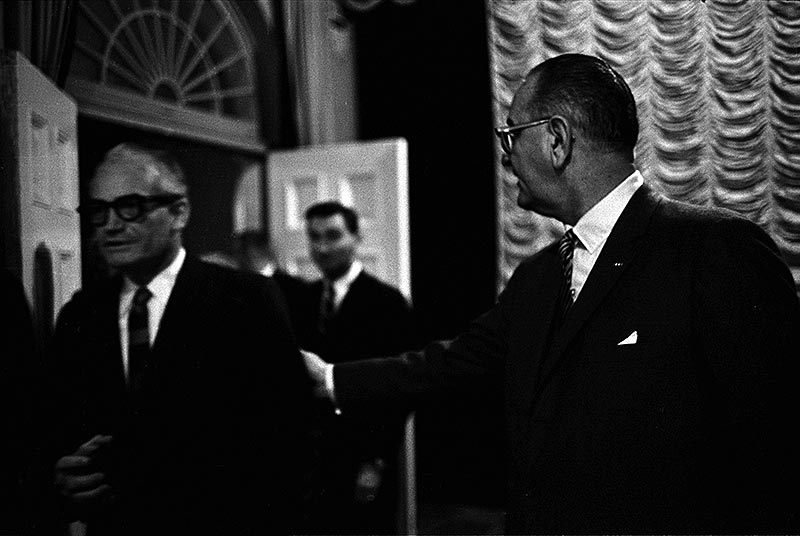
50 Years Ago: 2 Diné elected to Legislature

President Lyndon B. Johnson reaches out to Sen Barry Goldwater (R-Ariz.) in January 1964. (Photo courtesy of Wikipedia - Denmark)
WINDOW ROCK
It was a presidential election year and after numerous articles about Barry Goldwater and Lyndon Johnson, the election issue of the Navajo Times tackled the big issues of the day.
Stories like Chief Proud Eagle has a new television program and Navajo Bible School holds its anniversary for the entire month of November.
The paper did have a box on the top of the page saying “Johnson Wins by a Landslide” but nothing inside about the election or how it would affect the Navajo Tribe.
The paper did have a photo of Johnson taken a couple of weeks before walking off the stage at the University of New Mexico and if you look behind him, there was the smiling face of Navajo Tribal Chairman Raymond Nakai.
The big news, of course, that election day, was the election of two Navajos, Monroe Jymm, 30, and James D. Atcitty, to the state Legislature, representing McKinley and San Juan counties.
Jymm, who claimed Coyote Canyon as his home, was a student at UNM. The interesting part of the Navajo Times story was that Jymm’s grandfather, Monroe Jymm, was almost 100 years old and was a well-known medicine man. He registered to vote for the first time to cast a vote for his grandson.
In other news, the Navajo Times had been printing a lot of stories over the previous year on the efforts of Nakai and other tribal leaders to get the federal and state governments to stop arresting tribal members for use of peyote in Native American Church ceremonies.
But, in a rare instance, it also printed a letter from a man, identified as Fr. B.L., of the Two Story Trading Post, who had a different view of the use of peyote by tribal members:
“Dear sir,
“I would like to write a letter to you about an article on page 6 of your Oct. 29, 1964 issue about peyote.
“Me, I know much people have been cheating. I know I used peyote long time ago, in 1960, and peyote is not right. I am having trouble now with my mother because I was a peyote man.
“So many Navajo people are using peyote and having trouble around the Navajo Reservation. We are having blood trouble. Peyote is not right. Much cheating is caused by using peyote.
“I close now.”
The Navajo Times printed a story from the Honolulu Advertiser, which began with this sentence: “Four Navajo Indians went on the warpath here yesterday, but it was only to show hula enthusiasts how to do a war dance.”
It seems that Chief Grey Squirrel and his family, who come from a Navajo village 20 miles north of Gallup, had come to Honolulu to dance at an international rodeo and the writer decided to compare Navajo traditional dancers to that state’s traditional hula dancers.
“What do the hula and the war dance have in common? Not very much, it seems, except that a talent for both seems to run in the family,” the article stated.
The hula dance tells a story and the reporter asked Chief Grey Squirrel if that was also true with the war dance.
“The war dance,” he explained, ” is just like a football coach giving his team a pep talk before the game. It’s a warm up for battle. It doesn’t tell a story.”
Chief Grey Squirrel said the biggest problem his family has is in the making of the family’s costumes because since January 1963, federal law has prohibited killing an eagle and to get eagle feathers one has to send a request to the federal government and it takes a long time to get any feathers.
Bright Rainbow, one of his daughters, told the reporter that everyone in the family speaks fluent Navajo although at the school they go to, the principal forbids the students to speak anything but English.
But the students often break that rule, she said. “We talk Navajo secretly with the other kids,” she said.
The Times also printed another article from the Arizona Republic about 11 Navajo women who came to Phoenix over the past couple of months to better their lives.
The lead of the story, one that would be considered politically incorrect these days, read: “One little, two little, three little Indians … 11 little Indian girls.”








 Highway 264,
Highway 264, I-40, WB @ Winslow
I-40, WB @ Winslow